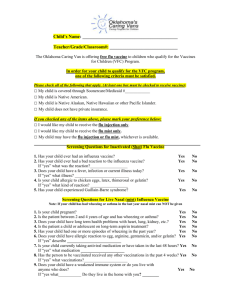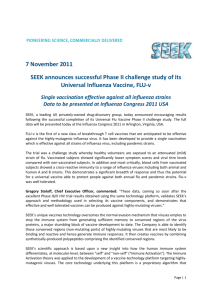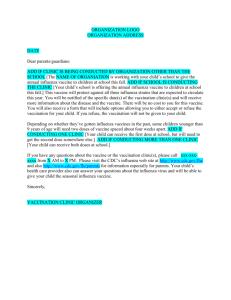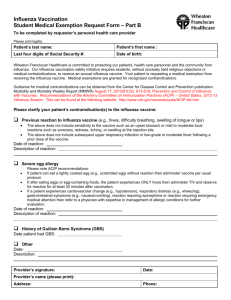Influenza Vaccine Virus Selection
advertisement
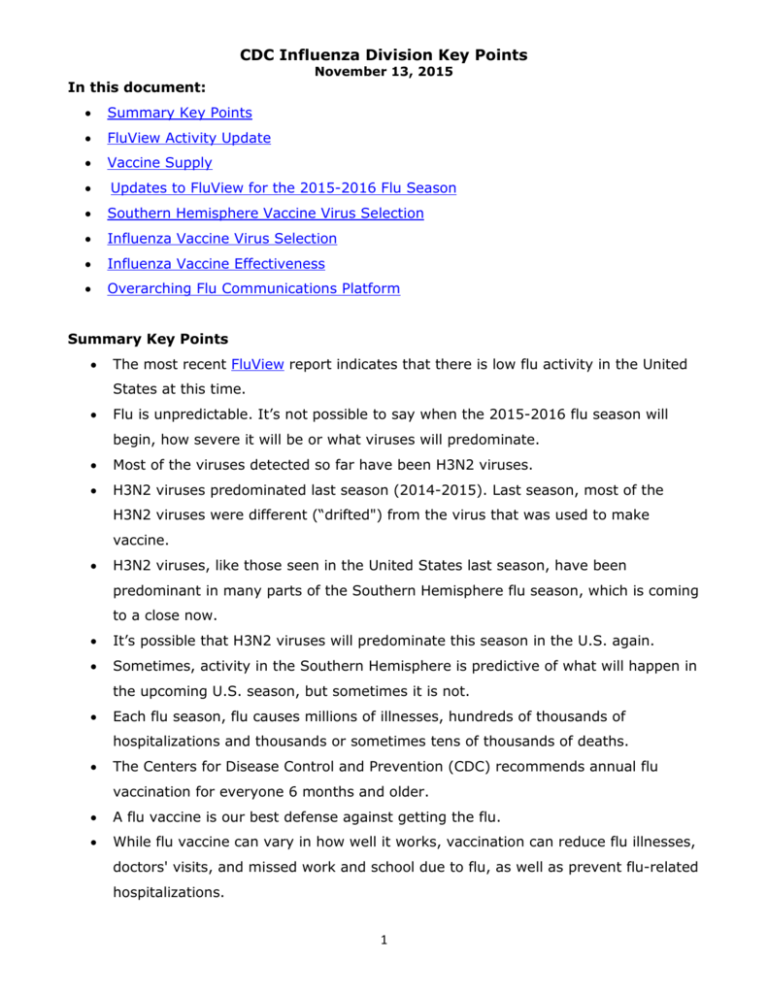
CDC Influenza Division Key Points In this document: November 13, 2015 Summary Key Points FluView Activity Update Vaccine Supply Updates to FluView for the 2015-2016 Flu Season Southern Hemisphere Vaccine Virus Selection Influenza Vaccine Virus Selection Influenza Vaccine Effectiveness Overarching Flu Communications Platform Summary Key Points The most recent FluView report indicates that there is low flu activity in the United States at this time. Flu is unpredictable. It’s not possible to say when the 2015-2016 flu season will begin, how severe it will be or what viruses will predominate. Most of the viruses detected so far have been H3N2 viruses. H3N2 viruses predominated last season (2014-2015). Last season, most of the H3N2 viruses were different (“drifted") from the virus that was used to make vaccine. H3N2 viruses, like those seen in the United States last season, have been predominant in many parts of the Southern Hemisphere flu season, which is coming to a close now. It’s possible that H3N2 viruses will predominate this season in the U.S. again. Sometimes, activity in the Southern Hemisphere is predictive of what will happen in the upcoming U.S. season, but sometimes it is not. Each flu season, flu causes millions of illnesses, hundreds of thousands of hospitalizations and thousands or sometimes tens of thousands of deaths. The Centers for Disease Control and Prevention (CDC) recommends annual flu vaccination for everyone 6 months and older. A flu vaccine is our best defense against getting the flu. While flu vaccine can vary in how well it works, vaccination can reduce flu illnesses, doctors' visits, and missed work and school due to flu, as well as prevent flu-related hospitalizations. 1 CDC Influenza Division Key Points November 13, 2015 The composition of this season’s vaccine has been updated to better match circulating viruses. The influenza A H3N2 and influenza B components were changed from last season. Laboratory data can give a general indication of how well the vaccine might work. Global laboratory data to date continues to indicate that most circulating influenza viruses are similar to the reference vaccine viruses used for developing the 20152016 U.S. vaccines. This suggests that vaccination with Northern Hemisphere influenza vaccine should offer protection against the majority of circulating viruses. CDC will continue to carefully look at the results of laboratory studies of currently circulating viruses to look for any evidence that viruses are changing. CDC also will conduct vaccine effectiveness studies to tell how well the vaccine is actually protecting against illness. Flu vaccine is designed to protect against three or four different flu viruses, depending on which vaccine you get. It takes about two weeks after vaccination for protection to set in. Now is a good time to get vaccinated. Manufacturers report having shipped more than 123.7 million doses of flu vaccine as of October 30, 2015. Go to http://vaccine.healthmap.org/ or www.cdc.gov/flu to find a location near you where you can get vaccinated. FluView Activity Update According to this week’s FluView report, overall seasonal influenza activity is low across the United States. CDC recommends an annual flu vaccine for everyone 6 months of age and older. Getting vaccinated before flu activity begins is best. Below is a summary of the key flu indicators for the week ending November 7, 2015: o For the week ending November 7, the proportion of people seeing their health care provider for influenza-like illness (ILI) is 1.4% and remains below the national baseline (2.1%). All 10 U.S. regions reported ILI activity below regionspecific baseline levels. o Puerto Rico experienced moderate ILI activity. New York City and all 50 states experienced minimal ILI activity. The District of Columbia did not have sufficient 2 CDC Influenza Division Key Points November 13, 2015 data to calculate an activity level. ILI activity data indicate the amount of flu-like illness that is occurring in each state. o Guam reported widespread influenza activity. Puerto Rico reported regional activity. Four states (Hawaii, Iowa, Massachusetts, and Oregon) reported local influenza activity. The District of Columbia and 39 states reported sporadic influenza activity. The U.S. Virgin Islands and 7 states reported no influenza activity. Geographic spread data show how many areas within a state or territory are seeing flu activity. o Influenza-associated hospitalization data from the Influenza Hospitalization Surveillance Network (FluSurv-NET) for the 2015-2016 influenza season will be updated weekly starting later this season. o The proportion of deaths attributed to pneumonia and influenza (P&I) based on the NCHS Mortality Surveillance System and the 122 Cities Mortality Reporting System is below their system-specific epidemic threshold. o At this time, no influenza-associated pediatric deaths have been reported for the 2015-2016 flu season. o Nationally, the percentage of respiratory specimens testing positive for influenza viruses in clinical laboratories during the week ending November 7 was 1.2%. For the most recent three weeks, the regional percentage of respiratory specimens testing positive for influenza viruses in clinical laboratories ranged from 0.3% to 2.7%. During the week ending November 7, 75 (58.6%) of the influenza-positive tests reported to CDC by clinical laboratories were influenza A viruses and 53 (41.4%) were influenza B viruses. o The most frequently identified influenza virus type reported by public health laboratories during the week ending November 7 was influenza A viruses, with influenza A (H3) viruses predominating. During the week ending November 7, 10 (55.6%) of the 18 influenzapositive tests reported to CDC by public health laboratories were influenza A viruses and 8 (44.4%) were influenza B viruses. Of the 8 influenza A viruses that were subtyped, 7 (87.5%) were H3 viruses and one (12.5%) was an A (H1N1)pdm09 virus. 3 CDC Influenza Division Key Points November 13, 2015 o CDC has characterized 335 U.S. flu viruses collected by U.S. laboratories during May 24–September 30, 2015, including 14 influenza A (H1N1)pdm09 viruses, 250 influenza A (H3N2) viruses, and 71 influenza B viruses. All 14 influenza A (H1N1)pdm09 viruses were antigenically characterized as A/California/7/2009-like, the influenza A (H1N1) component of the 2015-2016 Northern Hemisphere. All 250 H3N2 viruses were genetically sequenced and all viruses belonged to genetic groups for which a majority of viruses antigenically characterized were similar to A/Switzerland/9715293/2013, the influenza A (H3N2) component of the 2015-2016 Northern Hemisphere vaccine. A subset of 104 H3N2 viruses also were antigenically characterized; 103 of 104 (99%) H3N2 viruses were A/Switzerland/9715293/2013-like by HI testing or neutralization testing. 44 (62%) of the 71 influenza B viruses collected and analyzed during this period belonged to the B/Yamagata lineage, and all were antigenically similar to the B/Phuket/3073/2013 virus, the influenza B component for both the 2015–16 Northern Hemisphere trivalent and quadrivalent vaccines. The remaining 27 (38%) influenza B viruses were antigenically characterized as B/Brisbane/60/2008-like, the recommended influenza B component of the 2015-16 Northern Hemisphere quadrivalent flu vaccine. In addition, CDC has antigenically characterized ten specimens (1 influenza A (H1N1)pdm09, 8 influenza A (H3) and 1 influenza B/Yamagata-lineage) collected in the U.S. since October 1, 2015. o The eight H3N2 viruses collected since October 1, 2015 have been genetically sequenced and all viruses belonged to genetic groups for which a majority of viruses antigenically characterized were similar to A/Switzerland/9715293/2013, the influenza A (H3N2) component of the 2015-2016 Northern Hemisphere vaccine. Six viruses (one A (H1N1)pdm09, four A (H3N2), and one B/Yamagata-lineage) collected since October 1, 2015 have been antigenically characterized. All six were similar to the 2015-2016 Northern Hemisphere influenza vaccine components. 4 CDC Influenza Division Key Points November 13, 2015 Since October 1, 2015, CDC has tested 13 influenza A (H3N2) for resistance to the neuraminidase inhibitors antiviral drugs. None of the tested viruses were found to be resistant to either oseltamivir, zanamivir, or peramivir. FluView is available – and past issues are archived – on the CDC website. Note: Delays in reporting may mean that data changes over time. The most up to date data for all weeks during the 2015-2016 season can be found on the current FluView. Vaccine Supply Manufacturers projected that they would provide between 171 million and 179 million doses of influenza vaccine for the U.S. market during the 2015-2016 season. Early season supply projections can differ from the actual number of vaccine doses distributed at the end of the season based on a number of factors. Recently, some manufacturers have informed their customers about delays in shipments of certain vaccine formulations, however, overall there is no anticipated vaccine shortage of flu vaccine for the U.S. this season. Questions about supplies of specific formulations of vaccine should be referred to the individual manufacturers. As of October 30, 2015, 123.7 million doses of seasonal influenza vaccine have already been distributed in the U.S. This is about the same as the amount of vaccine distributed at the same time last season. The most doses of seasonal influenza vaccine ever distributed during one season was 155.1 million. Last season, 147.8 million doses were distributed. Information about vaccine supply during past seasons and weekly updates on distribution numbers for the current season are available on the CDC website at http://www.cdc.gov/flu/professionals/vaccination/vaccinesupply.htm . Updates to FluView for the 2015-16 Flu Season There are four updates to influenza surveillance reporting for the upcoming 20152016 flu season: 1.) Reports from public health and clinical laboratories will be presented separately in both FluView and FluView Interactive 5 CDC Influenza Division Key Points November 13, 2015 2.) Influenza B lineage data (B/Yamagata and B/Victoria) from public health laboratories will be presented in both FluView and FluView Interactive 3.) Two graphics illustrating the age distribution of influenza positive specimens reported from public health laboratories will be added and; 4.) Mortality data from the National Center for Health Statistics (NCHS) will be the principal tool to track influenza-associated mortality data in the United States. Presentation of Virologic Data Influenza testing practices differ in public health and clinical laboratories but both sources provide valuable information for monitoring influenza activity. Clinical laboratories primarily test respiratory specimens for diagnostic purposes and data from these laboratories provide useful information on the timing and intensity of influenza activity. Data from clinical laboratories include the weekly total number of specimens tested, the number of positive influenza tests, and the percent positive by influenza type. Public health laboratories primarily test specimens for surveillance purposes to understand what influenza viruses are circulating throughout their jurisdiction and the population groups being affected. Almost all the public health laboratories are using the CDC real-time RT-PCR assay with a fairly standard testing algorithm, allowing for consistent interpretation of virologic data at the national level. A subset of the influenza viruses collected by public health laboratories are sent to CDC for further characterization, including antiviral resistance testing and antigenic and/or genetic characterization, and this information is presented in the antiviral resistance and virus characterization sections of the FluView report. Data presented from public health laboratories will include the weekly total number of specimens tested, the number of positive influenza tests, and the number by influenza virus type, subtype, and influenza B lineage. However, in order to obtain enough specimens to produce this detailed information in an efficient manner, public health laboratories often receive samples that have already tested positive for influenza at a clinical laboratory. Because of this, 6 CDC Influenza Division Key Points November 13, 2015 monitoring the percent of specimens testing positive for influenza in a public health laboratory is less useful, but fortunately, is not necessary when clinical laboratory date is available. CDC offers a real-time RT-PCR test to identify influenza B viruses by lineage and the vast majority of public health laboratories have ordered these reagents. Beginning during the 2015-2016 season, CDC will be presenting influenza B lineage data (B/Yamagata and B/Victoria) in both FluView and FluView Interactive. In addition, the age group distribution of influenza positive tests also are summarized. Presentation of Mortality Data In the past, mortality surveillance was collected from the 122 Cities Mortality Reporting System and reported by the date the death certificate was registered in the vital records office. A newer system electronically records all U.S. deaths by date of death. Beginning during the 2015-2016 season, mortality data from this newer system utilized by the National Center for Health Statistics (NCHS) will be the principal component of the U.S. mortality surveillance system. Recent NCHS efforts to improve timeliness of jurisdiction reporting and modernize national vital statistics infrastructure have created a system capable of supporting near real-time surveillance. Capitalizing on these new capabilities, NCHS and CDC’s Influenza Division have partnered to use NCHS mortality surveillance data for P&I mortality surveillance. Other advantages of using the NCHS mortality data include: o NCHS data is presented by date of death while 122 CMRS is by date the death certificate was registered. The length of time from when a death occurs and when the death is registered in the vital statistics office can vary considerably. When deaths are presented by date of occurrence, rather than date the death certificate was filed, it provides a more accurate picture of the timing of P&I on overall mortality. o On average, the NCHS mortality system will report out almost twice the number of total deaths in a given week compared to the 122 CMRS. And 7 CDC Influenza Division Key Points November 13, 2015 over time, data from NCHS will include 100% of all deaths that occurred in the United States. This newer system was pilot tested last year. Users will be able to download weekly NCHS mortality data by region and/or state on CDC’s website at http://www.cdc.gov/flu/weekly/nchs.htm Users of the data should not expect the NCHS mortality surveillance data and the 122 Cities Mortality Reporting System to produce the same percentages. The percent P&I deaths from each system should be compared to the corresponding system specific baselines and thresholds. Southern Hemisphere Vaccine Virus Selection On September 24, 2015, WHO announced the recommended vaccine virus composition for the 2016 Southern Hemisphere vaccine. It is recommended that trivalent vaccines for use in the 2016 Southern hemisphere influenza season contain the following: o an A/California/7/2009 (H1N1)pdm09-like virus; o an A/Hong Kong/4801/2014 (H3N2)-like virus; o a B/Brisbane/60/2008-like virus. (a B/Victoria-lineage virus) It is recommended that quadrivalent vaccines containing two influenza B viruses contain the above three viruses and a B/Phuket/3073/2013-like virus (a B/Yamagata-lineage virus). There are two differences between what was recommended for the 2016 Southern Hemisphere vaccine and what is included in U.S. vaccines this season. o The H3N2 vaccine virus component was updated to provide incremental improvement in the match between vaccine and circulating viruses o For the trivalent vaccine, the B vaccine viruses were reversed to pre-empt an emerging trend which suggests that B/Victoria viruses will become predominant over B/Yamagata viruses. (For the trivalent vaccine, the B/Victoria vaccine virus now in the quadrivalent vaccine was substituted for the B/Yamagata virus; both the B/Victoria and B/Yamagata viruses are in the quadrivalent vaccines.) These updates are NOT a result of significant antigenic drift as occurred last season. Global laboratory data to date continues to indicate that most currently circulating influenza viruses are antigenically similar to the vaccine viruses included in the 2015-2016 U.S. influenza vaccines. 8 CDC Influenza Division Key Points November 13, 2015 This suggests that vaccination with Northern Hemisphere influenza vaccine should offer protection against the majority of circulating viruses. Influenza Vaccine Virus Selection Influenza viruses are constantly changing. The influenza viruses selected for inclusion in seasonal vaccines are updated each year based on which influenza viruses are circulating, how they are spreading, how well current vaccine components protect against newly identified viruses and what candidate vaccine viruses are available for vaccine production. Twice a year, the World Health Organization (WHO) organizes a consultation with the Directors of the WHO Collaborating Centers and Essential Regulatory Laboratories and representatives of key national laboratories. They review the available data and make recommendations on the composition of the influenza vaccine. These meetings take place in February for selection of the upcoming Northern Hemisphere’s seasonal influenza vaccine and in September for the Southern Hemisphere’s vaccine. More information about selecting the viruses to use in vaccine production is available at http://www.cdc.gov/flu/about/season/vaccine-selection.htm Influenza Vaccine Effectiveness Influenza vaccine can vary in how well it works. At least two factors play an important role in determining the likelihood that flu vaccine will protect a person from illness: o characteristics of the person being vaccinated (such as their age, health and immune status), and o the similarity or "match" between the vaccine viruses and the influenza viruses spreading in the community. The effectiveness of a vaccine can be reduced during seasons when one or more of the vaccine viruses selected are very different from (i.e., not “well-matched to”) the viruses that circulate the subsequent season. During seasons when vaccine viruses and circulating viruses are similar (i.e., “wellmatched”), overall vaccine effectiveness between 50% and 60% has been measured. Even during seasons when the vaccine match is good, the benefits of vaccination will vary across the population, depending on characteristics of the person being vaccinated and even, potentially, which vaccine was used. 9 CDC Influenza Division Key Points November 13, 2015 CDC performs many laboratory experiments on viruses circulating globally to characterize them in two major ways: o “genetically” – looking at the genetic relationship of the genes that encode the viruses, and o “antigenically” –looking at the immune response generated by the proteins on the surface of the virus. (One way to think of antigenic properties is as the immune signature of a virus.) These laboratory data inform the process of selecting ideal viruses to include in the vaccine and are also used as a proxy to infer how well the vaccine might work. While antigenic and genetic data can give a general indication of how well the vaccine might work, vaccine effectiveness studies are needed to determine how well the vaccine is working. In addition to year-round antigenic and genetic surveillance, CDC also carries out annual influenza vaccine effectiveness studies that measure how well the vaccine is protecting vaccinated people against medically-attended influenza virus illness. More information about vaccine effectiveness is available at http://www.cdc.gov/flu/about/qa/vaccineeffect.htm. 10 CDC Influenza Division Key Points November 13, 2015 Overarching Flu Communications Platform 1.) CDC RECOMMENDS A FLU VACCINE AS THE BEST WAY TO PROTECT AGAINST FLU 2.) EVERYDAY PREVENTIVE ACTIONS LIKE COVERING YOUR COUGH, STAYING AWAY FROM PEOPLE WHO ARE SICK AND WASHING YOUR HANDS OFTEN CAN HELP PREVENT THE SPREAD OF RESPIRATORY VIRUSES LIKE THE FLU. 3.) INFLUENZA ANTIVIRAL MEDICATIONS ARE AN IMPORTANT SECOND LINE OF DEFENSE AGAINST THE FLU. 1.) CDC RECOMMENDS A FLU VACCINE AS THE BEST WAY TO PROTECT AGAINST FLU The flu vaccine protects against three or four different influenza viruses, depending on which vaccine you got. Flu vaccination can reduce flu illnesses, doctors' visits, and missed work and school due to flu, as well as prevent flu-related hospitalizations. Vaccination is particularly important for people at high risk for serious flu-related complications and their close contacts. (People at high risk include infants, pregnant women, kids and adults with chronic medical conditions like asthma, diabetes, or heart disease, and adults aged 65 and older.) 2.) EVERYDAY PREVENTIVE ACTIONS LIKE COVERING YOUR COUGH, STAYING AWAY FROM PEOPLE WHO ARE SICK AND WASHING YOUR HANDS OFTEN CAN HELP PREVENT THE SPREAD OF RESPIRATORY VIRUSES LIKE THE FLU. Cover your nose and mouth with a tissue when you cough or sneeze—throw the tissue away after you use it. Stay away as much as you can from people who are sick. If you get the flu, stay home from work or school. If you are sick, do not go near other people so that you don't make them sick too. Wash your hands often with soap and water, especially after you cough or sneeze. If you are not near water, use an alcohol-based hand cleaner. Try not to touch your eyes, nose, or mouth. Germs often spread this way. These actions can help prevent the spread of influenza and other respiratory viruses during cold and flu season. 3.) INFLUENZA ANTIVIRAL MEDICATIONS ARE AN IMPORTANT SECOND LINE OF DEFENSE THAT CAN BE USED TO TREAT FLU. There are prescription drugs, called “influenza antiviral drugs” that can be used to treat the flu (or less commonly to prevent infection with flu viruses). Treatment with antivirals works best when begun within 48 hours of getting sick, but sometimes can still be beneficial when given later in the course of illness. Treatment with flu antiviral drugs can make your illness milder and shorter. Treatment with antivirals can also lessen the risk of being hospitalized or dying from flu. 11 CDC Influenza Division Key Points November 13, 2015 Antiviral drugs are safe and effective across all age groups and can be used in children and pregnant women. CDC recommends that all people at high risk from flu complications with symptoms consistent with influenza be treated with an influenza antiviral medical as soon as possible. High risk people should be treated. Otherwise healthy people can be treated at a health care provider’s discretion. There are three FDA-approved influenza antiviral drugs recommended by CDC this season to treat influenza. The brand names for these are Tamiflu® (generic name oseltamivir), Relenza® (generic name zanamivir), and Rapivab® (generic name peramivir). Visit http://www.cdc.gov/flu/professionals/antivirals/index.htm for information about how antiviral medications can be used to prevent or treat influenza when influenza activity is present in your community. 12


